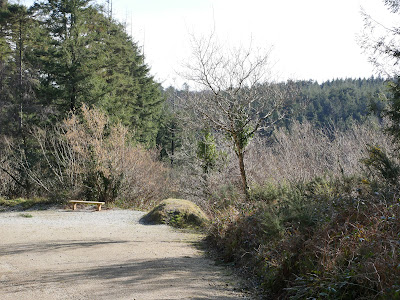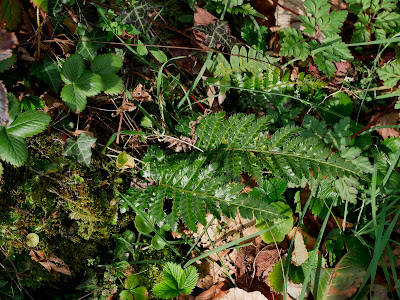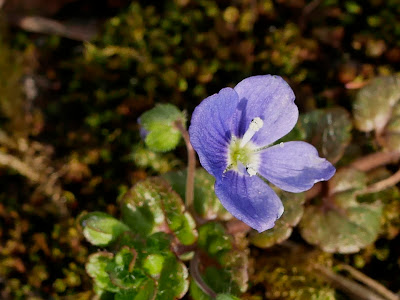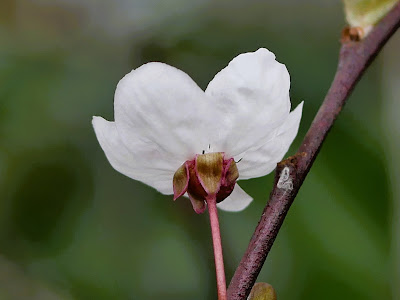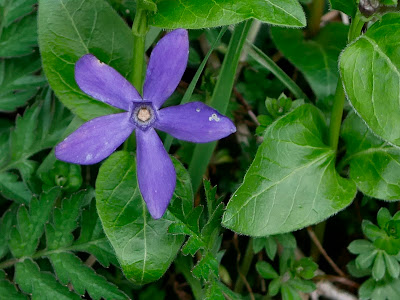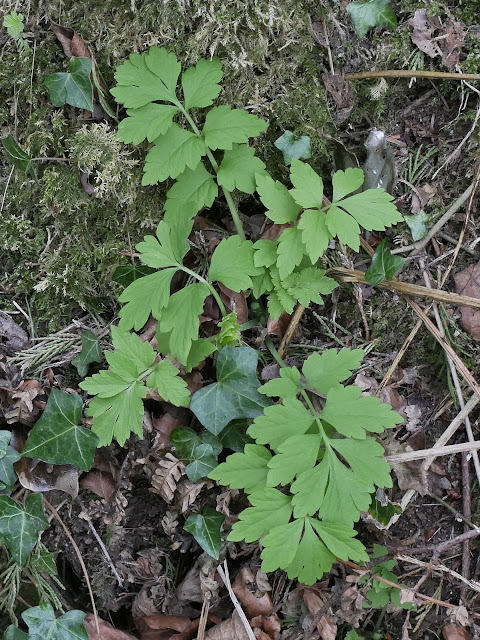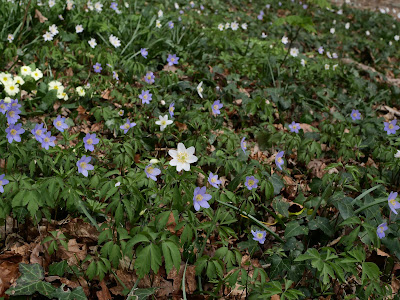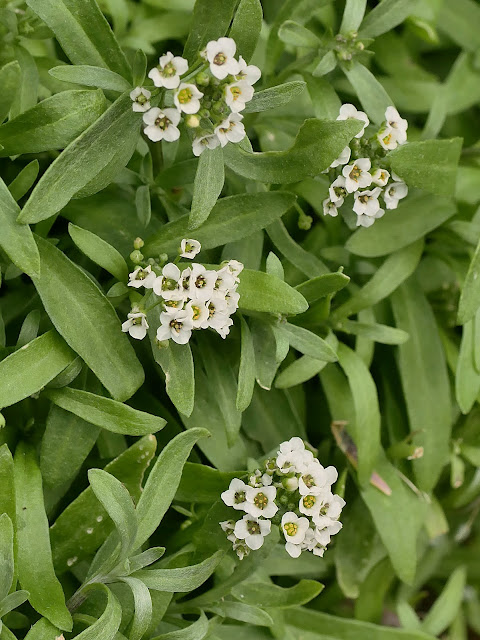March is the month where Winter and Spring battle it out, with temperatures ranging from 15 degrees C to below zero, sometimes within a 24 hour period. The first half of the month was chilly with a high pressure system bringing settled weather but accompanied by an arctic airflow. As such, many plants were slow to respond to the approaching Spring. However, one thing is constant in March; every day has a bit longer daylight than the last, culminating in the Spring equinox where there's more daylight each day than darkness, and regardless of the air temperatures, the plants will respond to that.
These are my finds for March in Cornwall.
As Spring approaches, woodlands are often a good place to search for emerging plant species and in early March, I went to the Cardinham area, which has a mix of woodland, rural lanes and a small village too.
Snowdrops were naturalised in many places; in wilder places such as along lanes, along streamsides and near gardens and churchyards as one might expect. By far the most common species is Common Snowdrop (Galanthus nivalis), but it's wise to look out for larger leaved species too, such as this one below which is likely the hybrid between Common and Pleated Snowdrop. I use a key that I photographed on my phone and refer to it when needed, and this plant keyed out nicely to it. The leaves were too wide for Common Snowdrop, they were glaucous and some leaves were pleated (folded over) and some weren't, and it also had hybrid vigour. It was fully naturalised along a stream away from roads and gardens. I took lots of photos to verify the finding, but most people just want to see the flowers.
Galanthus x valentinei

It's too late for this year, but here's the key if you want to use it for 2026.
Wild Daffodils were flowering in small numbers too at the beginning of March. They are much less tall and bulky than cultivated forms, with swept forward pale tepals and deeper yellow tube flowers. They're quite widespread in Cornwall, but are mainly found along riverbanks and old wooded valleys. These were growing in a small patch of woodland well away from habitation and there were hundreds of them coming up. It wasn't a new find though as they had previously been recorded from here before, but still they were lovely to see.
Narcissus pseudonarcissus subsp pseudonarcissus
Ornithopus perpusillus
Cardinham Woods, and the china clay aggregate path where the Birdsfoot was found.
Dog Mercury is now at its most obvious and in flower, though the species lack any petals, so it's an all green plant. It tends to favour older woodlands or wooded rural lane verges and as such it is considered an axiophyte in Cornwall, indicative of good habitat.
Mercurialis perennis
On a rural lane near Lanlivery, I noticed an unusual fern growing on a vegetated steep roadside bank. At first, I thought it was the Hard Shield Fern, but it didn't quite look right. I'd seen that species in Kent and it was cleaner in outline and the frond shape narrowed at the base. As such, I asked botanists online and my VCR, and both agreed it was a garden escape, the Japanese Shield Fern. It didn't look planted and wasn't with any other planted species. In fact, Soft Shield Fern was growing within a few feet of it.
Polystichum polyblepharum
Into the second week of March and the evenings were light enough for me to take a local walk near Wadebridge into a relict piece of woodland one afternoon. Moschatel was found and was close to opening its first flowers.
Adoxa moschatellina
Spring Crocus carpeted part of the woodland floor, having been planted some distance away, it had spread into the woodland proper by itself I suspect.
Crocus tommasinianus
Another garden escape which is widespread throughout England, is the Summer Snowflake. It was named as such by Linnaeus as in Sweden where it was first described, Summer was when it flowered. These had spread from planted ones near houses for over 100m down a stream into the woodland. Some were growing on the thinnest of soils on tree trunks, or actually in the stream, hardly places where someone would deliberately plant it.
Leucojum aestivum
Slender Speedwell was showing nicely along a road verge in grassy areas. It's the only Speedwell with kidney shaped leaves which you can see in the next photo, and it has bigger, brighter blue flowers than Common Field Speedwell. It's common in lawns and parks too.
Veronica filiformis
Along the same road verge, I found Sweet Violet. It was one of the two white forms; this one has hairy tufts inside the flower, the other doesn't.
Viola odorata var. dumetorum
I don't often photograph Primroses as they are so common, but here's a variant I don't see that often. This plant's flowers had a mix of 6 and 7 petals on each flower head, they usually only have 5. Other than that, it was simply nice to see carpets of Primroses at this time of the year. I also found some pink ones away from houses, and I have recently read that the wild Primrose can sometimes produce pink flowers, so they are not necessarily cultivars when you find that colour form.
Primula vulgaris
The first of many more to come, Greater Stitchwort was in flower on a road bank; this was taken on the 10th March.
Stellaria holostea
On the 15th March, Cornwall Botany Group had their AGM at Ladock village hall. After it concluded, I realised that there was still a few hours of daylight left, so I took a walk around the area to update some records. The next plant is Hartstongue Fern, a very common fern here, but it's always nice to see young ferns unfurling and to realise that they've been growing like this for millions of years.
Asplenium scolopendrium
In some damp woodland by the Tresillian River, I found a patch of Pink Purslane in flower. Of course, they are usually pink, but white forms aren't that uncommon, as shown here.
From the BSBI Atlas 2020 web page for this species "C. sibirica was cultivated in Britain by 1768 and was first noted in the wild in 1837 (Edensor, Derbyshire). It has spread rapidly since 1930; in Cornwall, for example, it was not recorded until the 1930s but is now very widespread." Native of eastern Asia and western North America.
Claytonia sibirica
Barren Strawberry now flowering in good numbers. Frequent on rural road verges, churchyards and Cornish hedges.
Potentilla sterilis
Cherry Plum is a small to medium sized tree that was very common in Kent, but not so here in Cornwall. It's often planted or young trees naturalise near to its parent. However, I found this one fgrowing out of the top of an old wall and was a good 5m tall, so clearly of some age. Given it's location, it was likely bird sown and not planted. They are the first Cherry tree to flower, with the flowers opening before the leaves (simultaneous in Wild Cherry). The sepals are reflexed and the twigs are reddish brown without thorns, distinguishing it from Blackthorn (also now in flower).
Prunus cerasifera
Identifying trees by their buds was never a favourite of mine through the Winter months, so it's nice when leaves and flowers start to burst forth making identification much easier. This is the Grey Willow with its catkins longer than wide as compared to the Goat or Pussy Willow (Salix caprea) which has short fat dumpy catkins. If visiting heathland from now onwards, you may also find small catkins snaking through the grass at ground level or just above, that one being Creeping Willow or Salix repens.
Salix cinerea
A very uncommon plant in Cornwall is the Yew tree, it shuns acidic soils and is often only found here where it was planted in churchyards. I found the sapling below not too far away from a village church with just such a Yew tree within its grounds. I guess this must be bird poop sown and its habitat within the mortar of a wall, is suitably alkaline for this species to germinate and develop.
Taxus baccata
Along the main road at Ladock were plenty of escaped Greater Periwinkles. It's almost always found not far from gardens or habitation, and I did see some like this a few days before at Harlyn Bay. This form with the narrow petals isn't that commonly found, though there are 113 records for it in the county since 1960. I bet it was about then or a few years before, that garden centres and nurseries starting selling this variant.
Vinca major var. oxyloba
Near Ladock, I was walking a lane when I came across a field now being used for storing bales. The farmer had laid down a crushed slate substrate and it was no longer cultivated. There was no gate, so I had a peek inside and found a nice rosette of Common Cudweed by the bales.
Filago germanica
Also surprising, were over 100 young plants of Jersey Cudweed, the evidence here possibly pointing to its dispersal and spread by agricultural vehicles and/or the importation of aggregate.
Laphangium luteoalbum
All in all, I totalled 151 records thus updating the database with post 2020 date class records and adding several new species too. Perhaps, after the 2026 AGM we should organise a field trip in the area afterwards?
Dandelion time is almost upon us, but there is one section within the micro species groups that can be identified for longer periods within the season. They are the spotted leaved Dandelions in Section Naevosa. Last year I found lots of Rona's Dandelion growing in a large amenity planter on Looe beach front. That find was verified by the referee. So it was nice on my return in mid March this year to find that they had spread to several planters and also onto the pavement.
Taraxacum ronae
On the other side of the Looe river at Hannafore, Wild Onions were coming up - and yes, you could pick them and put them in a salad if you wanted to, however, a huge number of dogs are walked here, so I wouldn't recommend doing that for obvious reasons.
Allium vineale
Sea Mouse-ear is starting to flower in large numbers along the coast now, the one below taken at Polzeath by the sandy car park. These are characterised by only having 4 petals, the only mouse-ear to have only 4. Confusion can arise as sometimes they may have 5 petals ( I found some like this in Kent) and they can then be confused with Little Mouse-ear (Cerastium semidecandrum). If that happens, you have to check for scarious bracts and I won't go into that until I find some to show you.
Cerastium diffusum
As you may have noticed, I photograph many rosettes and young plants during the colder months and below is Houndstongue, an uncommon plant in Cornwall. It helped that I had seen the plants flowering in the same location last year too; they're very soft and furry to the touch when young.
Cynoglossum officinale
Another young plant that I photographed had everyone online that I showed it to, baffled. Expert botanists across the country have tried to work out what it is and all are stumped, including some VCRs. I don't know either, so I'll have to return later in the year to see what this plant below turns out to be. Something very common probably! Given how small the leaves are, I initially thought Sheep's Sorrel, but the leaves lack the prominent lobes for that species. Some have suggested Convolvulus arvensis and even coastal Atriplex, though it's far too early for those to germinate.
Growing out of a wall about 50m from the cliffs in coastal turf, in sandy soil.
UPDATE: I returned in early April and the leaves had sufficiently grown to show the plant to be Field Bindweed, which no-one guessed from the tiny leaves shown.
Convolvulus arvensis
Common Dog Violets were flowering in large numbers by the 3rd week of March. I liked this photo as it included the small ferns (Asplenium adiantum-nigrum) on the Cornish hedge on which it was growing.
Viola riviniana
After a couple of weeks of seeing the Yellow Archangels with their flowers in bud, they finally opened on the 23rd of March. This was taken at St. Cleer Downs close to the Bodmin Moor. The native form of this species is uncommon here and it has been supplanted by the very successful garden escape form which has very showy leaves and slightly bigger flowers than the native one. It is now very widespread throughout Cornwall, whether in woodland or not.
Lamiastrum galeobdolon subsp argentatum
The first of the Field-wood Rush have started to flower; it favours short grassy areas and this was on someone's nicely mowed lawn. Being very small, they escape mowing unless it is a super low cut.
Luzula campestris
On a visit to a boggy area by a small stream near St Cleer I found a few clumps of Round-leaved Water Crowfoot with a few flowers out. It's probably the most common Water Crowfoot in Cornwall. When looking for plants like this, expect your boots to sink up to your ankles as these plants do like it wet!
Ranunculus omiophyllus
Looking remarkably like Wild Parsnips, I found these young plants on a Cornish hedge near St Cleer which turned out to be Welsh Poppy plants. Previously recorded here before, they are considered native to Cornwall and to the West of the UK generally. They have lovely bright pale yellow poppy flowers later in the year.
Papaver cambricum
Insects are also waking up, like this Violet Oil Beetle from St Cleer Downs. Separated from the Black Oil Beetle by having an indentation like a tooth at the base of the thorax. The kinked antennae show this to be a male. A good beetle resource can be found at buglife.org.uk
Meloe violaceus
Into the last week of March and the weather is settled and mild. An afternoon walk to Chapel Amble had some nice plants, such as lots of Musk Storksbill on the village grassy areas, and I even found a fasciated one with 12 flowers in 2 rows of 6, very unusual.
Erodium moschatum
Another rosette, this time it's Celery-leaved Buttercup growing in the mud at Middle Amble marshes.
Ranunculus sceleratus
After posting the above rosette on social media, a fungi expert noticed a rare smut fungus on the lower left leaf. It's called Entyloma ranunculi-scelerati with only 22 previous UK records and it turns out, a 1st record for Cornwall as a whole. It's only found on Ranunculus sceleratus and is quite distinctive with little brown circles on the leaves. I'll keep a look out for it in the future now.
Nearby was Ivy-leaved Water Crowfoot, though this was well developed with some flowers out too. I found it in its typical habitat of a waterlogged field entrance trampled by livestock.
Ranunculus hederaceus
Wandering around the village, I found many garden escapes such as Garden Grape Hyacinths, Garden Archangel, Seaside Daisy, Trailing Bellflowers and many more. However, as I walked into the village pub car park I found about 50 flowering plants of Rue-leaved Saxifrage, a native plant, new to the monad. It is increasing in numbers, especially in urban areaas and this is believed to be because of a reduction in sulphur dioxide pollution. As our air slowly gets cleaner, it favours plants such as this one.
Saxifraga tridactylites
I've never found Monkshood in the wild before, but one just appeared in front of me on a grass verge just outside Chapel Amble. It probably came from dumped garden waste in the past, but it was only growing with native plants. I hope to go back and see it in flower, possibly next month.
Aconitum napellus
Another new species for me was another garden escape naturalised on a rural road verge, though habitation was close by. Although the flowers were blue, the common name for this plant is Purple Gromwell. Some people know it by a synonym, Lithodora diffusa or Lithospermum diffusum.
Glandora diffusa
The month ended with some lovely plants. Thanks to social media networking us nature lovers, I was invited by a lovely lady called Brigit to go to a woodland near Liskeard where blue Wood Anemones were growing. I got there a bit early and while waiting for her I found two on the roadside, that's a good start! They are quite rare and usually hard to find.
Anemone nemorosa var. caerulea
I even managed to find a pink variant. For some reason the taxonomists haven't named this, but var. lilacina springs to mind as that's the name given to a similar coloured form of Sweet Violet.
Heath Wood-Rush was in flower in several places, it's very distinctive branches splaying out at all angles as well as downwards.
Luzula pilosa
Ramsons or Wild Garlic had finally burst into flower.
Allium ursinum
Teesdalia nudicaulis
I had also noticed the demise of one of the first flowers to open in late Winter/early Spring; Opposite leaved Golden Saxifrage was beginning to fade away as March ended, so enjoy each species while you can; they all fade away as time marches on.
I hope you enjoyed this rather lengthy selection of plants I found this March. It took a while for the plants to get going, but they are taking off fast now and I'm looking forward to what April might bring and I hope you are too.
Take care
Dave
@sylvatica2024.bsky.social






